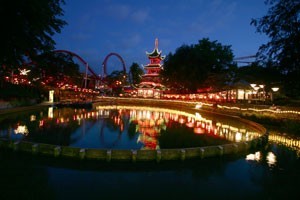
Visit the little Mermaid Statue in the harbour.
Visit the hippy village of Christiania and explore their art galleries, coffee shops, clothing stands and scavenged playgrounds.
Many museums are free on Tuesdays/Wednesdays.
Enjoy the "soft is", Denmark's rich, creamy soft ice cream: the best in the world. Top it with "guf", the pink marshmallow topping and you're in heaven.
Shopping or window-shopping on the long wandering shopping streets where vehicles are banned.
Train journey north along Zealand island to Helsinore Slot, the original 'Elsinore" where Shakespeare set his hamlet. This castle has a beautiful view across the water to Sweden, and cool dungeons you can tour.
Train journey to Odense, birthplace of Hans Christian Andersen, west to the island of Fyn
Train or boat journey way north to Skaaen, the Northernmost tip of Jutland, the Danish mainland. Here all the red brick houses have their roofs painted with white stripes. You can walk out onto a very special beach (or ride the tourist tractor,) and the land narrows into a tip, with an ocean on each side. The waves lap at you from both directions and you keep walking in until the land dissapears and the waves are crashing in from both sides, catching you in the middle. You feel a little bit like Moses, in reverse.
TIVOLI, the theme park that Walt Disney was inspired by and modeled Disneyland after. Downtown Copenhagen, with free pantomimes during the day after you pay the hefty admission fee to the park. Amusement park rides, treats, ice cream, gardens, and concerts.
Train journey to RIBE, in South East Jutland. The VIKING CITY, one of the oldest Viking settlements in Scandanavia.
Copenhagen is a fair weather friend and an entirely different city in the winter. Visit in summer when it rains less.
During WW2, Denmark was one of the first countries invaded by Hitler. The Danish king knew that resistance would be useless suicide and quickly surrendered. About a hundred hard-core patriotic Danes stormed to the border to fight the Germans and were quickly and efficiently destroyed.
The King rode through the streets of Copenhagen on his horse every day during the German occupation in an effort to keep danish morale high. Although Danes had little effect on stopping German troops, a Danish underground resistence network ensured that nearly all of Denmark's Jews were taken safely into hiding or shipped to safety in neutral Sweden. Thanks to this, fewer than 100 Danish jews were killed by the Nazis.
Partly because of the fact that Sweden was neutral during WW2 led to a Danish dislike of the Swedes. You can easily differenciate between Swedish names which often end in 'on'; eg. Hanson, Jenson, and Danish names which end in 'en'; eg. Hansen, Jensen.
The Danish version of John Smith is Jens Jensen.
By Ingi from Victoria